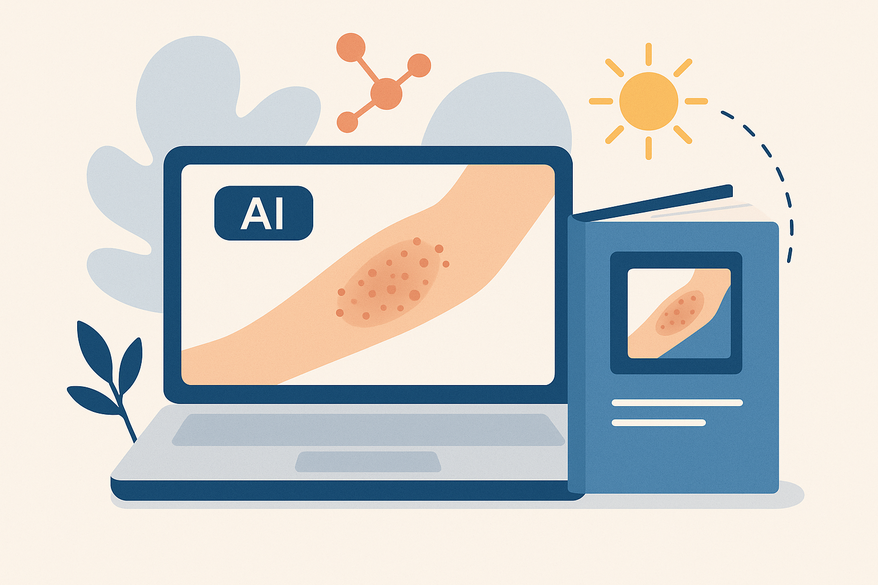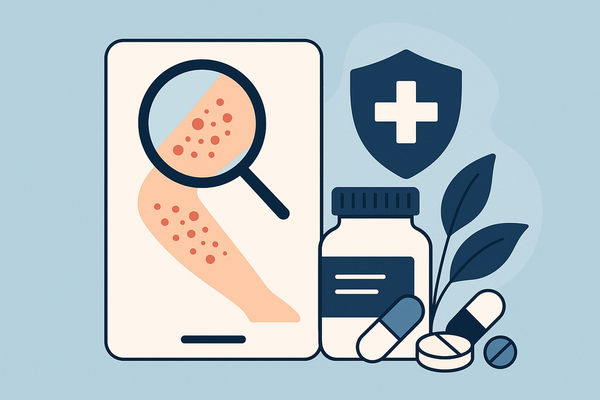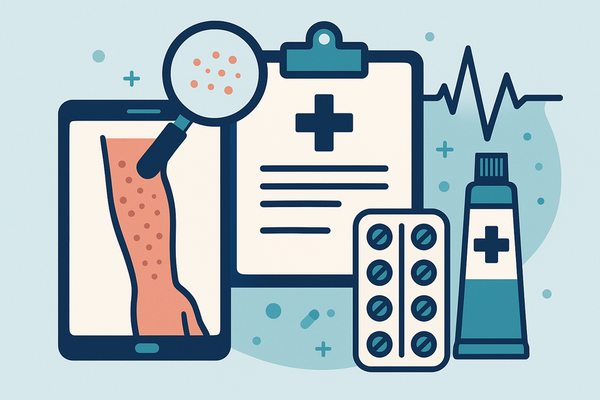What Your AI Rash Report Means: A Complete Guide for Interpreting AI-Generated Skin Assessments
Learn what your AI rash report means with this comprehensive guide to interpreting AI-generated skin assessments, including tips, benefits, and limitations.

Estimated reading time: 8 minutes
Key Takeaways
- AI rash reports use image analysis and machine-learning to suggest possible conditions rapidly.
- Reports include visuals, ranked diagnoses with confidence scores, severity indicators, likely causes, and recommended actions.
- These tools provide fast, consistent insights but require professional confirmation for definitive diagnosis.
- Follow self-care guidance and seek expert care for moderate to severe classifications.
- Understand AI’s benefits (speed, consistency) and limitations (contextual gaps, accuracy) to use it responsibly.
Table of Contents
- Introduction
- Section 1: Overview of AI-Generated Rash Reports
- Section 2: Key Components of an AI Rash Report
- Section 3: Interpreting Your AI Rash Report
- Section 4: Understanding the Benefits and Limitations
- Section 5: Practical Tips for Following Up
- Conclusion
- FAQ
Understanding what your AI rash report means is essential as more people turn to technology for skin-health insights. An AI rash report is a digital assessment generated by machine-learning systems that analyze images or descriptions of skin rashes to suggest possible conditions, severity levels, and next steps. With health apps and teledermatology on the rise, users need to interpret AI-generated rash reports responsibly. In this guide, we’ll cover:
- An overview of how AI systems create rash reports
- Key report components and medical terminologies
- Step-by-step interpretation tips
- Benefits versus limitations of AI rash assessments
- Practical follow-up advice
- Common FAQs and answers
Armed with this information, you’ll know how to read your AI rash report, what each section means, and when to seek professional medical advice.
Apps like Rash Detector harness AI-driven image analysis to generate detailed rash reports in minutes, helping you pinpoint possible conditions and next steps faster than ever.

Section 1: Overview of AI-Generated Rash Reports
How AI-Generated Rash Reports Are Produced
- User Upload: You take a photo of the rash or enter symptom details in an app.
- Image & Data Analysis: Computer vision and pattern-recognition algorithms compare your input against extensive medical image libraries and clinical symptom databases.
- Structured Report Output: The system compiles findings into sections—possible diagnoses, severity indicators, likely causes, and recommended actions.
- Machine-Learning Models: Deep-learning networks refine accuracy by training on millions of annotated dermatology images.
Distinguishing AI from Traditional Assessments
- Speed: AI offers near-instant feedback, often within minutes, while in-person visits require scheduling and waiting.
- Consistency: Algorithms apply the same criteria across cases, reducing variability from human fatigue or bias.
- Preliminary Scope: AI provides early guidance but lacks the full context of a clinician’s history-taking and feel for skin texture.
- Accessibility: Users worldwide can access AI tools on smartphones, bridging gaps in dermatology coverage.
For a deeper dive into the technical process behind AI rash diagnosis, see How AI Diagnoses Rashes.
Section 2: Key Components of an AI Rash Report
This section breaks down the UI elements and medical terms you’ll see in your AI rash report.
- Image Analysis Results
- Highlighted Areas: AI overlays heatmaps or colored outlines on photos to show concern zones.
- Visual Indicators: Hot spots often correspond to inflammation or texture changes.
- Possible Diagnoses
- Ranked List: Conditions (e.g., eczema, contact dermatitis, fungal infection) sorted by confidence percentage.
- Statistical Probability: Each entry shows how likely the algorithm believes that diagnosis is (see interpreting rash diagnosis scores).
- Severity Indicators
- Categories: Mild (self-care), Moderate (monitor closely), Severe (seek immediate care).
- Scoring Basis: Algorithmic assessment of lesion size, color intensity, spread.
- Possible Causes
- Common Triggers: Allergens (poison ivy, nickel), infections (bacterial, viral), chronic issues (psoriasis).
- Contextual Clues: AI uses pattern matching to suggest likely causes based on rash appearance and input data.
- Recommended Actions
- Self-Care Tips: Clean the area, apply over-the-counter treatments, avoid irritants.
- Medical Advice: When to consult a dermatologist or primary-care provider.
- Safety Note: AI guidance complements but does not replace professional diagnosis.
Section 3: Interpreting Your AI Rash Report
Follow these steps to make sense of each section in your AI rash report.
- Review Visuals
- Identify highlighted zones on your skin image.
- Note how heatmap intensity corresponds to inflammation zones.
- Read Possible Diagnoses
- Examine each listed condition along with its confidence percentage.
- Compare descriptions against your experience (e.g., itching vs. pain).
- Understand Severity Classification
- Mild: Likely safe for home remedies.
- Moderate: Watch for changes; schedule a checkup if symptoms persist.
- Severe: Urgent care or specialist referral recommended.
- Check Suggested Causes
- Look for triggers like new soaps, medications, or environmental exposures.
- Confirm if AI noted recent travel, pet contact, or occupational hazards.
- Follow Recommended Actions
- Follow self-care guidance: use hypoallergenic cleansers, cool compresses, or topical steroids as advised.
- Seek medical attention when AI flags urgent conditions or when symptoms worsen.
Section 4: Understanding the Benefits and Limitations
This section weighs the advantages of AI rash reports against their potential pitfalls.
Benefits of AI Rash Report
- Speed: Instantaneous results, reducing wait times for preliminary insight.
- Consistency: Uniform analysis unaffected by human fatigue or variation in expertise.
- Broad Data Reference: Access to millions of skin images and symptom records for pattern matching.
Limitations of AI Rash Report
- Diagnostic Accuracy: May miss rare, atypical, or nuanced presentations that a trained dermatologist would catch.
- Contextual Gaps: Often lacks complete patient history, lifestyle factors, or co-morbidities unless manually provided.
- Professional Oversight Needed: AI serves as guidance, not definitive diagnosis—clinical correlation required.
Data security is also critical—learn more about ensuring your information is protected in rash diagnosis tools at rash detection app data security.
Section 5: Practical Tips for Following Up
- Do Not Self-Treat Solely on AI Insights – AI can guide home care but may miss deeper causes.
- Seek Professional Care for Severe Flags – If the report indicates “severe” or urgent conditions, schedule a telehealth or in-person visit immediately.
- Save & Share Report Outputs – Download PDFs, screenshots, and heatmaps. Provide these to your healthcare provider for quicker evaluation.
- Record Additional Details – Track other symptoms: fever, pain, itchiness intensity. Note medical history: allergies, chronic conditions, recent travel.
- Review App Privacy Policies – Confirm data encryption and user-consent practices.
Conclusion
Knowing what your AI rash report means can empower you to take informed next steps for your skin health. We’ve covered:
- How AI systems generate rapid, consistent rash assessments
- Core report components—visuals, diagnoses, severity indicators, causes, and recommended actions
- Step-by-step interpretation to understand confidence levels and urgency
- Key benefits (speed, consistency, data breadth) and limitations (accuracy gaps, contextual needs)
- Practical follow-up tips to guide safe use
Remember, AI-generated reports are supportive tools that augment—but do not replace—professional medical evaluation. Combine your AI insights with expert clinical advice to ensure the best outcomes for your skin health.
FAQ
- How accurate are AI rash reports?
- Accuracy varies by platform and condition. AI excels at identifying common rashes like eczema or contact dermatitis, with reported accuracies up to 80–90% in studies, but declines for rare or unusual skin presentations.
- Can I use my AI rash report to self-diagnose and treat?
- No. AI reports offer guidance but are not a substitute for professional evaluation. Always confirm diagnosis and treatment plans with a licensed healthcare provider.
- What if the report is unclear or conflicting?
- Treat the AI output as one piece of information. If confidence scores are low or diagnoses conflict, share all report data with a clinician for further testing or biopsy if needed.
- Are my images and data secure?
- Most reputable apps employ encryption, secure cloud storage, and comply with privacy laws (HIPAA, GDPR). Always review the app’s privacy policy before uploading personal health data.





